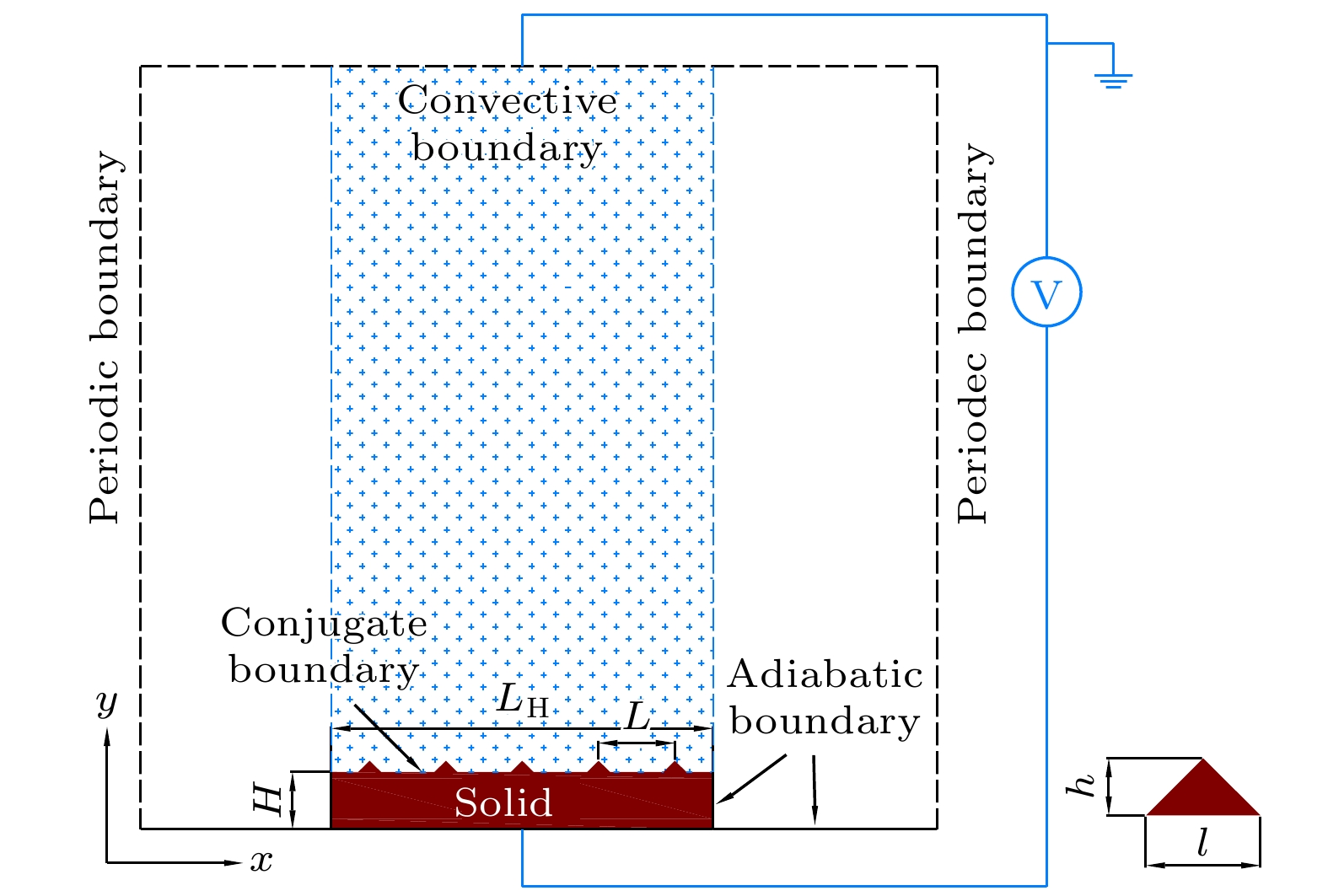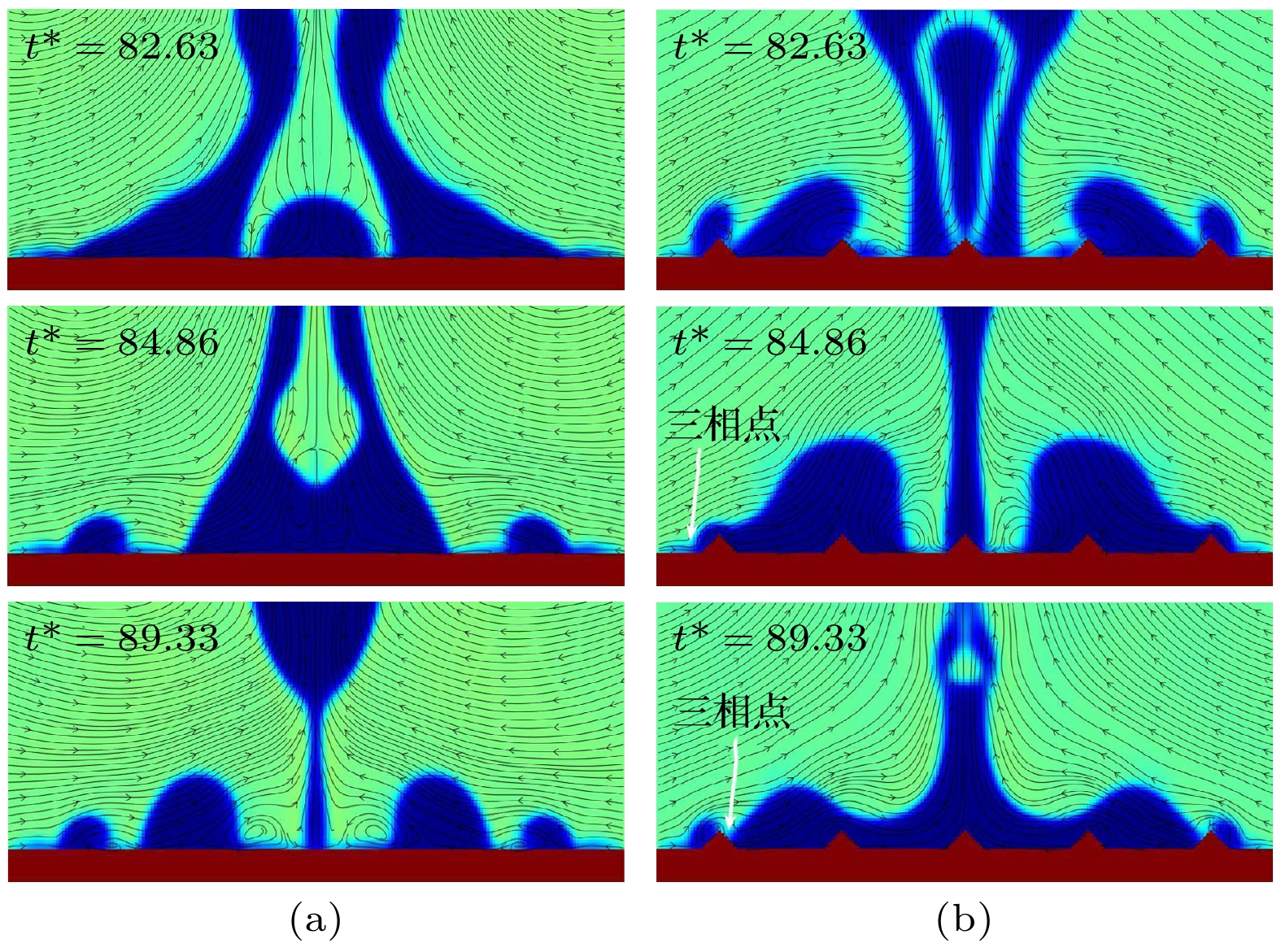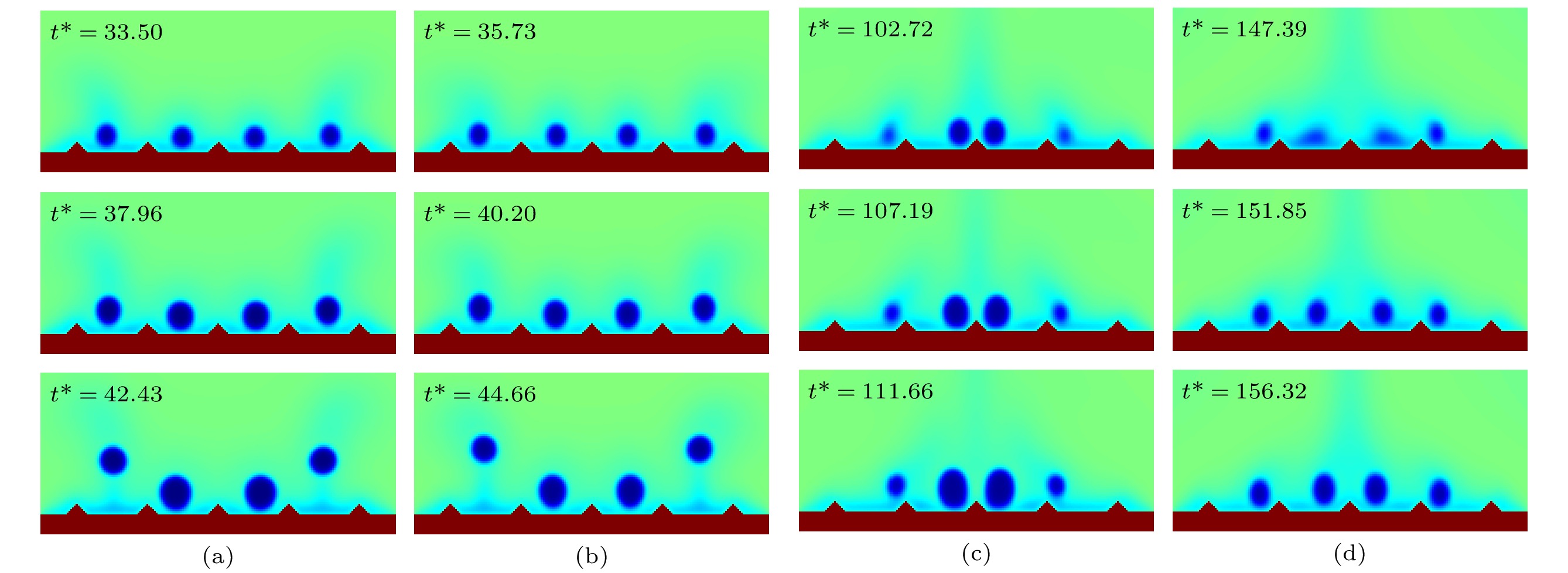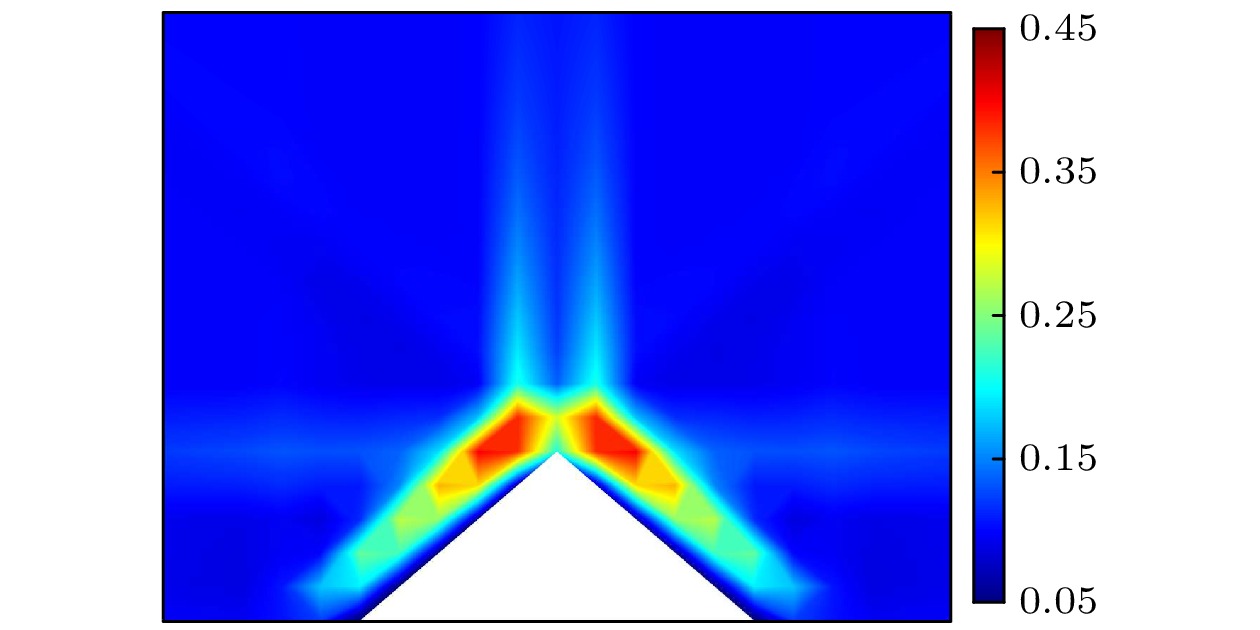-
The saturated pool boiling heat transfer on a conical structure surface under the action of an electric field is numerically investigated by using the lattice Boltzmann (LB) model coupled with an electric field model. A comparison study of boiling heat transfer phenomenon smooth surface and conical surface without the action of an electric field is first conducted in order to quantitatively analyze the mechanism of the electric field effect on boiling heat transfer on the conical structure surface. It is discovered that the conical structure has more active nucleation sites during the nucleate boiling regime, improving the boiling heat transfer efficiency and enhancing the critical heat flux (CHF). However, in the transition boiling stage and film boiling stage, the conical structure increases the flow resistance of the fluid on the fin surface, hindering heat transfer between the vapor and liquid and producing lower heat transfer performance than smooth surface. Based on the aforementioned findings, the boiling heat transmission on the conical structure surface is enhanced by applying an electric field. Numerical results indicate that the effect of the electric field on the boiling heat transfer performance on the conical structure surface is related to the boiling regime. In the earlier stage of the nucleation boiling regime, when an electric field is present, the onset time of bubble nucleation is slightly delayed, bubble size decreases a little, and boiling is slightly suppressed. However, the combination effect of electric field and conical structure, especially the tip effect, prevents the spread and diffusion of dry areas on the heating surface, thereby enhancing boiling heat transfer in the fully developed nucleate boiling stage. The tip effect grows more evidently in the transition boiling regime and film boiling regime, and increasing electric field intensity causes boiling to continue in the nucleate boiling regime at a higher superheat level. As a result, boiling heat transfer performance is greatly improved, and CHF steadily rises.
-
Keywords:
- conical structure /
- electric field /
- lattice Boltzmann method /
- pool boiling
[1] Zaidi S 2015 Chem. Eng. Res. Des. 98 44
 Google Scholar
Google Scholar
[2] Massih A R, Persson S 1992 J. Nucl. Mater. 188 323
 Google Scholar
Google Scholar
[3] Mohammed H I, Giddings D, Walker G S 2019 Int. J. Heat Mass Transfer 130 710
 Google Scholar
Google Scholar
[4] Nikolayev V S, Chatain D, Garrabos Y, Beysens D 2006 Phys. Rev. Lett. 97 184503
 Google Scholar
Google Scholar
[5] Li W, Dai R K, Zeng M, Wang Q W 2020 Renew. Sust. Energ. Rev. 130 109926
 Google Scholar
Google Scholar
[6] Tian Z, Etedali S, Afrand M, Abdollahi A, Goodarzi M 2019 Powder Technol. 356 391
 Google Scholar
Google Scholar
[7] Wei J J, Honda H 2003 Int. J. Heat Mass Transfer 46 4059
 Google Scholar
Google Scholar
[8] Li Q, Zhao J H, Sun X Z, Liu B 2022 Appl. Therm. Eng. 215 118924
 Google Scholar
Google Scholar
[9] Kong X, Zhang Y H, Wei J J 2018 Exp. Therm. Fluid Sci. 91 9
 Google Scholar
Google Scholar
[10] Kim S H, Lee C G, Kang J Y, Moriyama K, Kim M H, Park H S 2015 Int. J. Heat Mass Transfer 91 1140
 Google Scholar
Google Scholar
[11] Elkholy A, Swift J, Kempers R 2023 Appl. Therm. Eng 219 119665
 Google Scholar
Google Scholar
[12] Clubb L 1916 UK Patent 100796 [1916-07-09
[13] Dong W, Li R Y, Yu H L, Yan Y Y 2006 Exp. Therm. Fluid Sci. 30 579
 Google Scholar
Google Scholar
[14] Gao M, Cheng P, Quan X J 2013 Int. J. Heat Mass Transfer 67 984
 Google Scholar
Google Scholar
[15] Hristov Y, Zhao D, Kenning D B R, Sefiane K, Karayiannis T G 2009 Heat Mass Transfer 45 999
 Google Scholar
Google Scholar
[16] Garivalis A I, Manfredini G, Saccone G, Di Marco P, Kossolapov A, Bucci M 2021 NPJ Microgravity 7(1) 37
 Google Scholar
Google Scholar
[17] Quan X J, Gao M, Cheng P, Li J S 2015 Int. J. Heat Mass Transfer 85 595
 Google Scholar
Google Scholar
[18] Liu B, Garivalis A I, Cao Z, Zhang Y, Wei J 2022 Int. J. Heat Mass Transfer 183 122154
 Google Scholar
Google Scholar
[19] Liu X, Chai Z H, Shi B C 2019 Phys. Fluids 31 092103
 Google Scholar
Google Scholar
[20] Liu X, Chai Z H, Shi B C 2021 Commun. Comput. Phys. 30 1346
 Google Scholar
Google Scholar
[21] Feng Y, Li H, Guo K, Lei X, Zhao J 2019 Int. J. Heat Mass Transfer 135 885
 Google Scholar
Google Scholar
[22] Li W X, Li Q, Chang H Z, Yu Y, Tang S 2022 Phys. Fluids 34 123327
 Google Scholar
Google Scholar
[23] Lou Q, Wang H Y, Li L 2023 Phys. Fluids 35 123327
 Google Scholar
Google Scholar
[24] Ezzatneshan E, Salehi A, Vaseghnia H 2023 Int. J. Therm. Sci 184 107913
 Google Scholar
Google Scholar
[25] Gong S, Cheng P 2012 Int. J. Heat Mass Transfer 55 4923
 Google Scholar
Google Scholar
[26] Guo Z L, Zheng C G, Shi B C 2011 Phys. Rev. E 83 036707
 Google Scholar
Google Scholar
[27] Chai Z H, Zhao T S 2012 Phys. Rev. E 86 016705
 Google Scholar
Google Scholar
[28] Panofsky W, Phillips M, Jauch J M 1956 Am. J. Phys. 24 416
[29] He X Y, Ning L 2000 Comput. Phys. Commun. 129 158
 Google Scholar
Google Scholar
[30] Chai Z H, Shi B C 2008 Appl. Math. Model. 32 2050
 Google Scholar
Google Scholar
[31] Chai Z H, Liang H, Du R, Shi B C 2019 SIAM J. Sci. Comput. 41 B746
 Google Scholar
Google Scholar
[32] Wang L, Wei Z C, Li T F, Chai Z H, Shi B C 2021 Appl. Math. Model. 95 361
 Google Scholar
Google Scholar
[33] Wang H Y, Lou Q, Liu G J, Li L 2022 Int. J. Therm. Sci. 178 107554
 Google Scholar
Google Scholar
[34] Lou Q, Guo Z L, Shi B C 2013 Phys. Rev. E 87 063301
 Google Scholar
Google Scholar
[35] Ladd A J C 1994 J. Fluid Mech. 271 285
 Google Scholar
Google Scholar
[36] Li L, Chen C, Mei R, Mei M, Klausner J 2014 Phys. Rev. E 89 043308
 Google Scholar
Google Scholar
[37] Gong S, Cheng P 2017 Int. Commun. Heat Mass Transfer 87 61
 Google Scholar
Google Scholar
[38] Li Q, Yu Y, Luo K H 2019 Phys. Rev. E 100 053313
 Google Scholar
Google Scholar
[39] Sadasivan P, Unal C, Nelson R 1995 J. Heat Transfer 117 558
 Google Scholar
Google Scholar
[40] 柴立和, 彭晓峰, 王补宣 1999 原子能科学技术 33 533
Chai L H, Peng X F, Wang B X 1999 Atomic Energy Sci. Techno. 33 533
[41] Berghmans J 1976 Int. J. Heat Mass Transfer 19 791
 Google Scholar
Google Scholar
[42] Johnson R 1968 AIAA J. 6 8
-
图 10 $ T_{\rm{b}}=0.96 T_{\rm{c}} $时, 不同电场强度下锥翅表面的沸腾过程 (a) E0 = 0; (b) E0 = 0.0517; (c) E0 = 0.0862; (d) E0 = 0.1207
Figure 10. Snapshots of boiling processes on the conical surface at $ T_{\rm{b}}=0.96 T_{\rm{c}} $ under different electric field intensities: (a) E0 = 0; (b) E0 = 0.0517; (c) E0 = 0.0862; (d) E0 = 0.1207
表 1 格子单位与物理单位转换
Table 1. The unit conversion from lattice unit to physical unit.
符号 格子单位 物理单位 转换因子 $ \rho_{\rm{l}} $ 5.426 570.02 $ {\rm{kg/m^3}} $ 106.16 $ {\rm{kg/m^3}} $ $ \rho_{\rm{v}} $ 0.8113 86.13 $ {\rm{kg/m^3}} $ 106.16 $ {\rm{kg/m^3}} $ $ l_0 $ 16 $ 4.72\times 10^{-6}\;{\rm{m}} $ $ 2.95\times 10^{-7}\;{\rm{m}} $ $ u_0 $ 0.0358 38.56 $ {\rm{m/s}} $ 1077.09 $ {\rm{m/s}} $ $ t_0 $ 447.8 $ 1.224\times 10^{-7}\;{\rm{s}} $ $ 2.734\times 10^{-10}\;{\rm{s}} $ $ \nu $ 0.06 $ 0.19\times 10^{-4}\;{\rm{m^2/s}} $ $ 3.18\times 10^{-4}\;{\rm{m^2/s}} $ $ T_{\rm{c}} $ 0.1961 647.2 $ {\rm{K}} $ 3300.36 $ {\rm{K}} $ $ p_{\rm{c}} $ 0.1784 $ 0.221\times 10^{8}\;{\rm{Pa}} $ $ 1.24\times 10^{8}\;{\rm{Pa}} $ $ c_{\rm{vl}} $ 4.0 1405.9 $ {\rm{J/(kg\cdot K)}} $ 351.48 $ {\rm{J/(kg\cdot K)}} $ $ h_{\rm{fg}} $ 0.624 $ 0.726\times 10^{6}\;{\rm{J/kg}} $ $ 1.16\times 10^{6}\;{\rm{J/kg}} $ $ \lambda_{\rm{s}} $ 32.556 390.67 $ {\rm{W/(m\cdot K)}} $ 12.0 $ {\rm{W/(m\cdot K)}} $ $ q_0 $ 0.01269 $ 1.69\times 10^{9}\;{\rm{J/(m^2\cdot s)}} $ $ 1.33\times 10^{11}\;{\rm{J/(m^2\cdot s)}} $ $ \varepsilon_0\varepsilon_{\rm{l}} $ 2.236 $ 1.98\times 10^{-11}\;{\rm{F/m}} $ $ 8.85\times 10^{-12}\;{\rm{F/m}} $ $ \varepsilon_0\varepsilon_{\rm{v}} $ 1 $ 8.85\times 10^{-12}\;{\rm{F/m}} $ $ 8.85\times 10^{-12}\;{\rm{F/m}} $ $ V $ 1 1096.96 $ {\rm{V}} $ 1096.96 $ {\rm{V}} $ -
[1] Zaidi S 2015 Chem. Eng. Res. Des. 98 44
 Google Scholar
Google Scholar
[2] Massih A R, Persson S 1992 J. Nucl. Mater. 188 323
 Google Scholar
Google Scholar
[3] Mohammed H I, Giddings D, Walker G S 2019 Int. J. Heat Mass Transfer 130 710
 Google Scholar
Google Scholar
[4] Nikolayev V S, Chatain D, Garrabos Y, Beysens D 2006 Phys. Rev. Lett. 97 184503
 Google Scholar
Google Scholar
[5] Li W, Dai R K, Zeng M, Wang Q W 2020 Renew. Sust. Energ. Rev. 130 109926
 Google Scholar
Google Scholar
[6] Tian Z, Etedali S, Afrand M, Abdollahi A, Goodarzi M 2019 Powder Technol. 356 391
 Google Scholar
Google Scholar
[7] Wei J J, Honda H 2003 Int. J. Heat Mass Transfer 46 4059
 Google Scholar
Google Scholar
[8] Li Q, Zhao J H, Sun X Z, Liu B 2022 Appl. Therm. Eng. 215 118924
 Google Scholar
Google Scholar
[9] Kong X, Zhang Y H, Wei J J 2018 Exp. Therm. Fluid Sci. 91 9
 Google Scholar
Google Scholar
[10] Kim S H, Lee C G, Kang J Y, Moriyama K, Kim M H, Park H S 2015 Int. J. Heat Mass Transfer 91 1140
 Google Scholar
Google Scholar
[11] Elkholy A, Swift J, Kempers R 2023 Appl. Therm. Eng 219 119665
 Google Scholar
Google Scholar
[12] Clubb L 1916 UK Patent 100796 [1916-07-09
[13] Dong W, Li R Y, Yu H L, Yan Y Y 2006 Exp. Therm. Fluid Sci. 30 579
 Google Scholar
Google Scholar
[14] Gao M, Cheng P, Quan X J 2013 Int. J. Heat Mass Transfer 67 984
 Google Scholar
Google Scholar
[15] Hristov Y, Zhao D, Kenning D B R, Sefiane K, Karayiannis T G 2009 Heat Mass Transfer 45 999
 Google Scholar
Google Scholar
[16] Garivalis A I, Manfredini G, Saccone G, Di Marco P, Kossolapov A, Bucci M 2021 NPJ Microgravity 7(1) 37
 Google Scholar
Google Scholar
[17] Quan X J, Gao M, Cheng P, Li J S 2015 Int. J. Heat Mass Transfer 85 595
 Google Scholar
Google Scholar
[18] Liu B, Garivalis A I, Cao Z, Zhang Y, Wei J 2022 Int. J. Heat Mass Transfer 183 122154
 Google Scholar
Google Scholar
[19] Liu X, Chai Z H, Shi B C 2019 Phys. Fluids 31 092103
 Google Scholar
Google Scholar
[20] Liu X, Chai Z H, Shi B C 2021 Commun. Comput. Phys. 30 1346
 Google Scholar
Google Scholar
[21] Feng Y, Li H, Guo K, Lei X, Zhao J 2019 Int. J. Heat Mass Transfer 135 885
 Google Scholar
Google Scholar
[22] Li W X, Li Q, Chang H Z, Yu Y, Tang S 2022 Phys. Fluids 34 123327
 Google Scholar
Google Scholar
[23] Lou Q, Wang H Y, Li L 2023 Phys. Fluids 35 123327
 Google Scholar
Google Scholar
[24] Ezzatneshan E, Salehi A, Vaseghnia H 2023 Int. J. Therm. Sci 184 107913
 Google Scholar
Google Scholar
[25] Gong S, Cheng P 2012 Int. J. Heat Mass Transfer 55 4923
 Google Scholar
Google Scholar
[26] Guo Z L, Zheng C G, Shi B C 2011 Phys. Rev. E 83 036707
 Google Scholar
Google Scholar
[27] Chai Z H, Zhao T S 2012 Phys. Rev. E 86 016705
 Google Scholar
Google Scholar
[28] Panofsky W, Phillips M, Jauch J M 1956 Am. J. Phys. 24 416
[29] He X Y, Ning L 2000 Comput. Phys. Commun. 129 158
 Google Scholar
Google Scholar
[30] Chai Z H, Shi B C 2008 Appl. Math. Model. 32 2050
 Google Scholar
Google Scholar
[31] Chai Z H, Liang H, Du R, Shi B C 2019 SIAM J. Sci. Comput. 41 B746
 Google Scholar
Google Scholar
[32] Wang L, Wei Z C, Li T F, Chai Z H, Shi B C 2021 Appl. Math. Model. 95 361
 Google Scholar
Google Scholar
[33] Wang H Y, Lou Q, Liu G J, Li L 2022 Int. J. Therm. Sci. 178 107554
 Google Scholar
Google Scholar
[34] Lou Q, Guo Z L, Shi B C 2013 Phys. Rev. E 87 063301
 Google Scholar
Google Scholar
[35] Ladd A J C 1994 J. Fluid Mech. 271 285
 Google Scholar
Google Scholar
[36] Li L, Chen C, Mei R, Mei M, Klausner J 2014 Phys. Rev. E 89 043308
 Google Scholar
Google Scholar
[37] Gong S, Cheng P 2017 Int. Commun. Heat Mass Transfer 87 61
 Google Scholar
Google Scholar
[38] Li Q, Yu Y, Luo K H 2019 Phys. Rev. E 100 053313
 Google Scholar
Google Scholar
[39] Sadasivan P, Unal C, Nelson R 1995 J. Heat Transfer 117 558
 Google Scholar
Google Scholar
[40] 柴立和, 彭晓峰, 王补宣 1999 原子能科学技术 33 533
Chai L H, Peng X F, Wang B X 1999 Atomic Energy Sci. Techno. 33 533
[41] Berghmans J 1976 Int. J. Heat Mass Transfer 19 791
 Google Scholar
Google Scholar
[42] Johnson R 1968 AIAA J. 6 8
Catalog
Metrics
- Abstract views: 822
- PDF Downloads: 49
- Cited By: 0















 DownLoad:
DownLoad:
















